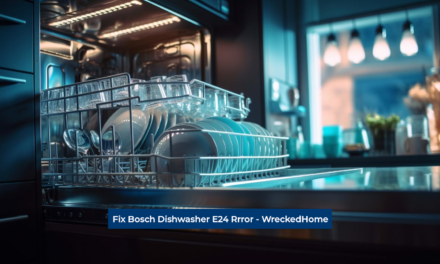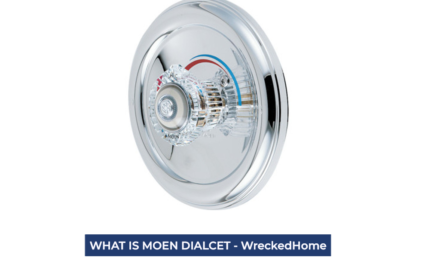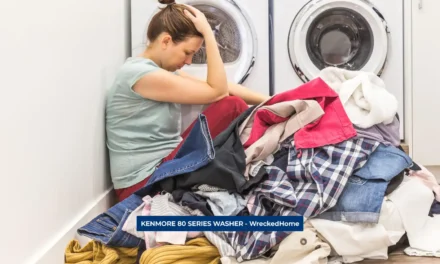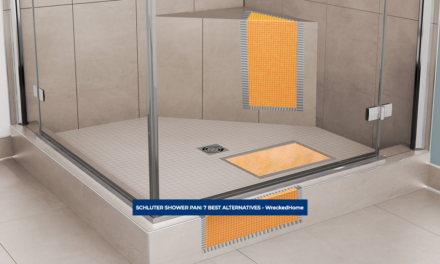You come home after a long day and want a relaxing warm shower. But, what you notice is your water heater leaking from top and is not working. Now, what will you do? We suggest you do not panic because it is not a big issue. The water heater leaking from top is in a bit more favorable condition than the water leaking from its bottom. So, calm down. You are not in the worst situation.
But, this issue can be harmful to your heater if you don’t solve it swiftly. That’s why our expert team decided to give you the solutions to this problem. You can trust our solutions as we are ISCET-licensed professionals. We are going to discuss some reasons for this issue along with their solutions.
8 Reasons Why Water Heater Leaking from Top
There can be various reasons for this leaking, and each problem requires another type of solution. So, we are going to discuss problems along with their solutions in this article.
1. Cold or Hot Water Inlet and Outlet Valves
There are two types of valves in your water heater. The cold inlet valve lets cold water from the plumbing system into your tank. Then, the hot water outlet valve lets the hot water from the tank into the home’s plumbing system.
So, when the water heater leaking from top, the issue can be in these valves. They are either loosened, corroded, or not fitting properly.
Solution: To solve this issue, you need to switch off your water heater to avoid any electrical issues or further damage.
If you have an electrical water heater, you need to turn off the heater’s breaker switch in your circuit box. If you are unable to find its breaker, switch off your main breaker.
But, if you have a gas water heater, simply turn off the gas valve. It may be present behind or on the side of your water heater.
Now, use a paper towel and wipe the water from the top of your heater. Also, use it to locate the leaking point. You can feel the point with the help of paper.
When you find it, switch off your inlet and outlet valve. For it, you need to turn the valve in a clockwise direction.
Now, use a wrench to tighten the valve. If it still leaks, you need to replace it.
2. Temperature and Pressure Relief Valve
This valve is used for maintaining pressure in your water tank. When the temperature or pressure increases in your tank, this valve enables the tank to release the excessive water.
This valve is present either on the top or side of your tank. It maintains your water heater. So, if it becomes faulty, your heater can explode.
If you notice the leak from this valve, it means that either it is faulty, loose, or has dirt in it.
Solution: The best solution to the issue is to replace the valve. It will keep your water heater safe, avoiding any type of other mishap.
But, if water is leaking from the connections, you need to tighten it. Use a wrench to do this task. And, place teflon tape around it.
Moreover, you can also open the valve to get rid of any debris in it. To do this, you need to put a bowl underneath the overflow tube. Then pull the tab, pointing straight out, to open the valve. Now, clean it and fix it back.
3. Anode Rod Corrosion
There is a thin, long rod in your water tank which attracts corrosive elements of water. It saves your water tank from corrosion as it becomes corroded.
But when the corrosion reaches the top of the rod, it eats it up which leads to the water heater leaking from top.
Solution: In this case, you need to replace your rod as soon as possible. If it has become completely corroded, it can’t save your tank from corrosion. In this case, your tank and water heater will start corroding.
4. Water Heater Corrosion
Another cause for the water heater leaking from top is that it has been corroded. This corrosion can cause a hole on the top of it from where water can leak.
This corrosion may happen because your anode rod has been corroded a long time ago. So, it is unable to save your tank from corrosion.
Solution: The only solution to this issue is the replacement of your water heater. It has become useless for you so you need a new one in its place.
Visit our store for 10% off our Save Home Energy products here.
5. Condensation
Condensation is a process in which the whole body of your water heater becomes wet.
In this process, when cold water enters your tank and heats it, almost half a gallon of water vapors are created per hour. These vapors accumulate on the body of the water heater, making it wet.
In the gas heaters, it is a normal process, but in electric heaters, it happens mostly when the heater is in a cold place.
Solution: Condensation is not an issue that you need to address. But, you should confirm if wetness is due to leakage or condensation.
For it, wipe the whole body with a towel. Then wait for a few hours. If the wetness on the heater is in the same pattern as it was before, it is because of condensation. So, just relax.
6. Pipes Fittings
There are inlet and outlet fitting points on the pipe. These fittings are known as dielectric nipples. With time, they may corrode or get loose. This is not a big issue but it can lead to the water heater leaking from top.
Solution: You should check the connecting point where the pipe is connected to the inlets. If that point is leaking, you need a wrench to tighten it.
But if they are corroded, you need to replace them. It is not a big task and will not take much of your time or effort. So, don’t worry.
7. Rainwater
It can happen that rainwater accumulates on the top of your water heater. It may be the case when there are heavy pours and high winds. So, you may mistake rainwater for the leakage.
If you own a gas water heater, you can face this issue more often than the electric one. Because in it, rainwater can travel to the top of the heater through the flue vent pipe.
Solution: This is not much of an issue that needs to be solved. But, you should check your water heater after every stormy weather. If there is rainwater on the top of it, drain it out.
If this water remains on the top for a long time, it can cause a hole in it. This hole can cause the leakage.
8. Expansion Tank Leakage
Your water heater has an expansion tank which is on the side of your water heater. When the pressure of water increases in your heater, it transfers it to the expansion tank. Over time, when the tank is used on a regular basis, it can corrode and start leaking.
Solution: Inspect your expansion tank for the source of leakage. If it is leaking from its pipe fittings, you can tighten them. Or, replace them if they are faulty.
But, if leakage doesn’t stop even after doing all of this, you need to replace your tank.
So, these are the eight issues why the water heater leaking from top. But, you must know how to avoid these issues.
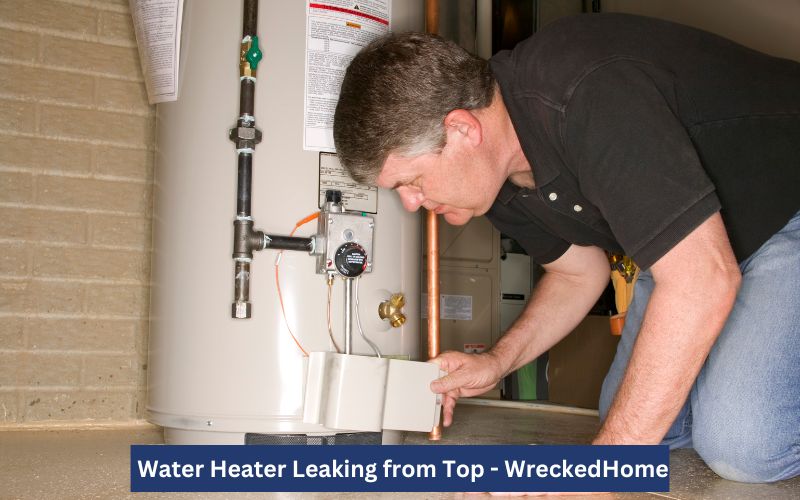
How to Avoid Water Heater Leaking from Top?
We are going to tell you some maintenance tips which can ensure that your water heater never leaks.
1. Inspect on a Regular Basis
You should inspect your water heater now and then to ensure that it is working properly. Look for any signs of corrosion or rusting, and address this issue as soon as possible.
2. Flush it Yearly
You need to flush the water out of your water heater once a year. It will ensure that no sediments build up in your heater. Because these sediments can impact the efficiency of your heater over time.
To flush it, you need to shut off the power and water supply to your heater. Then, let the water cool down. After that, attach the hose and let water out of the heater.
Then, refill it with water. When it is full, turn on the water heater.
3. Replace Anode Rod
You need to replace the anode rod after every five years. Keep inspecting it once a year to check its corrosion. When it is worn out, you should substitute it with a new one.
4. Insulate the Tank
You should insulate the tank as it reduces energy bills and enhances its life. The insulation avoids heat loss which means that the heater doesn’t need to work hard. Moreover, it also lessens the strain on the tank.
5. Replace Temperature and Pressure Valves
You should check these valves annually for any sign of corrosion. If they start getting loose, you should tighten them.
You should also ensure that they are working properly. For it, you need to put a bucket in the drain pipe that is attached to this valve.
Now, lift the lever. Water should come out. After that, lower the lever so that the water stops. If it doesn’t, there is an issue with your valve and it needs to be replaced.
So, these are the five maintenance tips.
Conclusion
Water heater leaking from top can be a nightmare for homeowners. Because replacing it can cost them a hefty amount of money. That’s why you should focus on maintaining it.
For any repairs, installations, builds, or questions; We recommend you to hire a professional. Find A Pro Near You Here!


